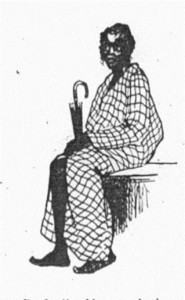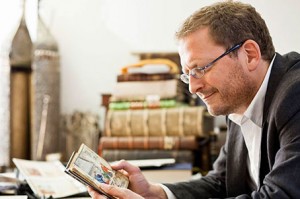In Germany, you cannot rely on the weather being consistently sunny, even in the summertime. In the fall at the latest – dare we think of it already? – we will need to shake open our umbrellas again. Axel Stähler (comparative literature, University of Kent), has shown that the umbrella was once considered a Jewish attribute. He recently offered to share with Blogerim his research on the umbrella’s discursive significance in Wilhelminian Germany.
Dr. Stähler, how did you spot the “Jewish umbrella”?

Mbwapwa Jumbo from “Briefe aus Neu-Neuland”, Schlemiel 1.1 (November 1903), p. 2
I was first struck by an umbrella in the hands of the “Big Chief of Uganda,” Mbwapwa Jumbo, a fictitious reporter in the Jewish satirical magazine Schlemiel, who acted as a correspondent from a new Jewish colony in Africa. In fact, in 1903, the British government had proposed to Theodor Herzl to commit land to Jewish settlers in the British Protectorate of East Africa. This proposal, which came to be known as the Uganda Plan, was vehemently disputed in the Zionist movement, and rejected in 1905. No concerted colonial Jewish settlement of Uganda ever took place, although individual Jewish immigrants had built homes there earlier.
In nine letters published over the course of the magazine’s brief lifespan, from 1903 to 1907, the chatty and naïvely amicable Mbwapwa tells of the first Jewish colonists – Orthodox Mizrachi – and of what became of them: in funny prose spotted with Anglicisms, and increasingly also Yiddishisms, he describes how he and his countrymen converted to Judaism. He relates the murder of a reformist rabbi who had been smuggled into the country, and the reformers’ ensuing punitive military expedition. He reports on the colony’s political and cultural trials and tribulations, and, finally, on the emergence of the Zionist movement—since Uganda was not, after all, the Promised Land. → continue reading
When I first heard that the Jewish congregation of Pinneberg is giving “church asylum” to a Muslim, I had to chuckle. The article about it in the online magazine Migazin put the words “church asylum” in quotation marks and used a picture of the dome of the synagogue on Berlin’s Oranienburger Straße – making the linking together of the three monotheistic religions appear intentional.
But now I heard from a friend that there’s a film about the Kiddush asylum at the Pinneberg congregation for a man from the Sudan, and I had to wonder why “church asylum” isn’t “synagogue asylum”.
The Kiddush is a blessing spoken over a goblet of wine at the beginning of a holy day, in order to sanctify the day. Church asylum, as I learned from the film, is actually about a sacred room that protects people who are under threat. The Jewish congregation in Pinneberg has one such room. And it is encouraging to hear – as the head of the congregation explains in the film – why they are using this space to protect a person, at least temporarily, from persecution.
Rosa Fava, director of the “Diversity in Schools” project
in Conversation with Emile Schrijver, Curator of the Braginsky Collection
What made you decide to be curator of a manuscript collection?
When I studied Hebrew in Amsterdam, a lecturer took us to see the University of Leiden’s collection of medieval manuscripts. In the impressive vaults, I saw ancient manuscripts for the first time: the only manuscript of the Jerusalem Talmud (Yerushalmi), for instance, and one of the earliest Rashi manuscripts. Seeing these ancient sources, and gaining first-hand experience of living history, was overwhelming. Historical books had a strong effect on me. I subsequently studied at the Bibliotheca Rosenthaliana, the Jewish library at the University of Amsterdam, where I later began to work. A few years ago, Mr. Braginsky was looking for a curator for his first exhibition in Europe. Mutual acquaintances from the international circle of manuscript specialists put us in touch with one another. We got along well and were soon able to establish a good, trusting working relationship
What do you do as a curator of the Braginsky Collection?

Emile Schrijver and the Harrison Miscellany © and photo: Darko Todorovic, Dornbirn (A)
I take care of the collection. I am responsible for Mr. Braginsky’s new acquisitions and for his existing objects. Most new acquisitions are delivered with a short description. Others we describe and photograph, before adding them to our inventory. I carefully examine the books’ condition and, if necessary, commission their restoration. I’m also responsible for monitoring the climate in the storerooms. Inquiries concerning exhibitions and reproductions are a lot of work for us. The process of digitizing our stock is ongoing. Occasionally, scholars wish to view specific works at length. We also organize presentations on our own premises, on behalf of the European Association of Jewish Museums, for example. Public relations for events such as the Jewish Book Week in London in 2013 likewise require a great deal of preparation.
What makes the Braginsky Collection so special? → continue reading

